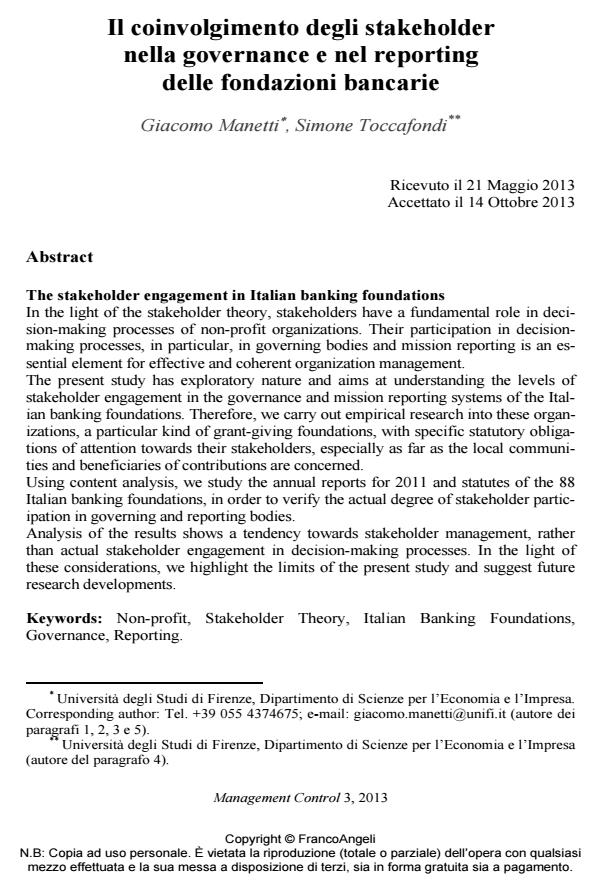Il coinvolgimento degli stakeholder nella governance e nel reporting delle fondazioni bancarie
Titolo Rivista MANAGEMENT CONTROL
Autori/Curatori Giacomo Manetti, Simone Toccafondi
Anno di pubblicazione 2014 Fascicolo 2013/3
Lingua Italiano Numero pagine 26 P. 51-76 Dimensione file 701 KB
DOI 10.3280/MACO2013-003004
Il DOI è il codice a barre della proprietà intellettuale: per saperne di più
clicca qui
Qui sotto puoi vedere in anteprima la prima pagina di questo articolo.
Se questo articolo ti interessa, lo puoi acquistare (e scaricare in formato pdf) seguendo le facili indicazioni per acquistare il download credit. Acquista Download Credits per scaricare questo Articolo in formato PDF

FrancoAngeli è membro della Publishers International Linking Association, Inc (PILA)associazione indipendente e non profit per facilitare (attraverso i servizi tecnologici implementati da CrossRef.org) l’accesso degli studiosi ai contenuti digitali nelle pubblicazioni professionali e scientifiche
In the light of the stakeholder theory, stakeholders have a fundamental role in decision- making processes of non-profit organizations. Their participation in decisionmaking processes, in particular, in governing bodies and mission reporting is an essential element for effective and coherent organization management. The present study has exploratory nature and aims at understanding the levels of stakeholder engagement in the governance and mission reporting systems of the Italian banking foundations. Therefore, we carry out empirical research into these organizations, a particular kind of grant-giving foundations, with specific statutory obligations of attention towards their stakeholders, especially as far as the local communities and beneficiaries of contributions are concerned. Using content analysis, we study the annual reports for 2011 and statutes of the 88 Italian banking foundations, in order to verify the actual degree of stakeholder participation in governing and reporting bodies. Analysis of the results shows a tendency towards stakeholder management, rather than actual stakeholder engagement in decision-making processes. In the light of these considerations, we highlight the limits of the present study and suggest future research developments.
Parole chiave:Non-profit, Stakeholder Theory, Italian Banking Foundations, Governance, Reporting.
- La valutazione del CdA in contesti ad elevata concentrazione proprietaria: mero conformismo o reale strumento di valutazione? Romilda Mazzotta, Giovanni Bronzetti, Graziella Sicoli, Paolo Tenuta, in MANAGEMENT CONTROL 2/2018 pp.107
DOI: 10.3280/MACO2018-002006 - Capacity building nelle organizzazioni nonprofit: come le fondazioni d'erogazione rinforzano i propri beneficiari Andrea Bafundi, Giacomo Boesso, Fabrizio Cerbioni, in MANAGEMENT CONTROL 2/2025 pp.39
DOI: 10.3280/MACO2025-002003 - Rendicontare l'impatto sociale. Metodologie, indicatori e tre casi di sperimentazione in Toscana Marco Bellucci, Carmela Nitti, Chiara Chimirri, Luca Bagnoli, in MANAGEMENT CONTROL 3/2019 pp.166
DOI: 10.3280/MACO2019-003009
Giacomo Manetti, Simone Toccafondi, Il coinvolgimento degli stakeholder nella governance e nel reporting delle fondazioni bancarie in "MANAGEMENT CONTROL" 3/2013, pp 51-76, DOI: 10.3280/MACO2013-003004